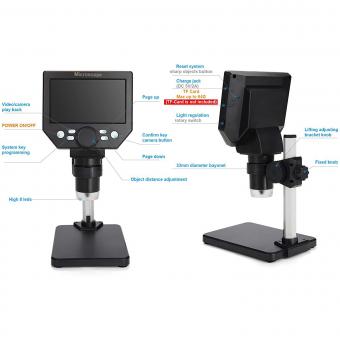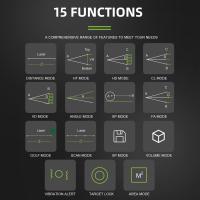Can You See Yeast Under A Microscope ?
Yes, yeast can be seen under a microscope.
1、 Yeast morphology and cellular structure under a microscope
Yes, yeast can be seen under a microscope. Yeast is a type of fungus that belongs to the Saccharomyces cerevisiae species, commonly used in baking and brewing. When observed under a microscope, yeast cells appear as oval-shaped structures, typically measuring around 5-10 micrometers in diameter.
Yeast morphology and cellular structure can be examined using various microscopy techniques. Light microscopy is commonly used to observe yeast cells, allowing for a general visualization of their shape, size, and arrangement. However, to study yeast in more detail, higher-resolution techniques such as electron microscopy can be employed.
Under an electron microscope, yeast cells reveal a more intricate cellular structure. The cell wall, which surrounds the yeast cell, can be observed as a thick outer layer. Inside the cell wall, the plasma membrane can be seen as a thin, delicate structure that separates the cytoplasm from the external environment. Within the cytoplasm, various organelles such as the nucleus, mitochondria, and endoplasmic reticulum can be visualized.
It is worth noting that recent advancements in microscopy techniques, such as super-resolution microscopy, have allowed for even more detailed visualization of yeast cells. These techniques enable researchers to study the subcellular structures and dynamics of yeast in greater depth, providing insights into their cellular processes and functions.
In conclusion, yeast can indeed be seen under a microscope. By employing different microscopy techniques, researchers can explore the morphology and cellular structure of yeast, shedding light on their biology and contributing to our understanding of this important microorganism.

2、 Identifying yeast species through microscopic examination
Yes, yeast can be seen under a microscope. Microscopic examination is a common method used to identify yeast species. Yeast cells are typically round or oval in shape and can vary in size depending on the species. They are single-celled organisms that reproduce asexually through budding or fission.
When examining yeast under a microscope, various characteristics can be observed to help identify the species. These include cell size, shape, and arrangement, as well as the presence of specific structures such as pseudohyphae or true hyphae. Additionally, staining techniques can be used to visualize specific cellular components, such as the cell wall or internal structures.
Advancements in microscopy techniques have greatly improved the ability to identify yeast species. High-resolution microscopy, such as confocal microscopy, allows for detailed examination of yeast cells and their structures. Fluorescent dyes can be used to label specific components, enabling better visualization and identification.
However, it is important to note that microscopic examination alone may not always be sufficient for accurate identification of yeast species. Molecular techniques, such as DNA sequencing, are often used in conjunction with microscopy to confirm species identification. DNA sequencing provides a more precise and reliable method for distinguishing between closely related yeast species.
In conclusion, yeast can be seen under a microscope, and microscopic examination is a valuable tool for identifying yeast species. However, the use of molecular techniques is often necessary to complement microscopy and ensure accurate species identification.

3、 Yeast reproduction and life cycle observed through microscopy
Yes, yeast can be observed under a microscope. Yeast is a type of fungus that belongs to the Saccharomyces genus, and it is commonly used in baking and brewing processes. When observed under a microscope, yeast cells appear as small, oval-shaped structures. They are typically around 5-10 micrometers in diameter, making them visible under a light microscope.
Yeast reproduction and life cycle can also be observed through microscopy. Yeast cells reproduce asexually through a process called budding. During budding, a small bud forms on the parent cell, which eventually grows and separates to become a new individual yeast cell. This process can be observed under a microscope as the formation and detachment of the bud.
In addition to asexual reproduction, yeast can also undergo sexual reproduction. This involves the fusion of two haploid yeast cells to form a diploid cell, which then undergoes meiosis to produce haploid spores. The process of sexual reproduction in yeast can also be observed under a microscope, allowing researchers to study the different stages of meiosis and spore formation.
Microscopy has been instrumental in understanding the life cycle and reproductive processes of yeast. It has provided valuable insights into the cellular mechanisms involved in yeast reproduction, as well as the genetic and molecular aspects of yeast biology. With advancements in microscopy techniques, such as fluorescence microscopy and live-cell imaging, researchers can now observe yeast cells in real-time and gain a deeper understanding of their behavior and interactions.
In conclusion, yeast can be seen under a microscope, and microscopy has played a crucial role in studying yeast reproduction and life cycle. It has allowed scientists to observe the various stages of yeast reproduction, both asexual and sexual, and has contributed to our understanding of yeast biology.

4、 Visualizing yeast fermentation process using a microscope
Yes, you can see yeast under a microscope. Yeast is a single-celled organism that belongs to the fungi kingdom. It is commonly used in baking and brewing processes due to its ability to ferment sugars and produce carbon dioxide and alcohol. When observing yeast under a microscope, you can see its distinct oval or spherical shape, as well as its cytoplasm and nucleus.
To visualize the yeast fermentation process using a microscope, you would typically prepare a wet mount slide by placing a small sample of yeast in a drop of water or a nutrient-rich medium. The slide is then covered with a coverslip to prevent evaporation and to keep the yeast in place. By adjusting the focus and magnification of the microscope, you can observe the yeast cells and their activity.
Under the microscope, you may notice the yeast cells undergoing budding, a process where a smaller daughter cell forms on the surface of the larger mother cell. This is a characteristic feature of yeast reproduction. Additionally, you may observe the movement of yeast cells, as they can exhibit a slight motility.
It is important to note that the ability to visualize yeast under a microscope depends on the quality of the microscope and the staining techniques used. Staining the yeast cells with dyes such as methylene blue or iodine can enhance their visibility and provide more detailed information about their structure and function.
In recent years, advancements in microscopy techniques have allowed for more detailed observations of yeast cells. For example, fluorescent microscopy can be used to label specific components within the yeast cells, such as the cell membrane or specific organelles, providing a clearer understanding of the fermentation process.
Overall, visualizing yeast under a microscope is a valuable tool for studying its fermentation process and gaining insights into its cellular structure and behavior.






























There are no comments for this blog.